dbltree
Super Moderator
January 9th, 2012
Understanding white/ladino clover
All that most landowners know about clover is what they read in ads in hunting magazines but there is so much more they need to know! The ads insinuate that their clover can grow huge racks and draw deer for miles....neither of which is true and they fail to share the fact that their clovers are not drought resistant nor capable of providing grazing well into winter or withstand intensive grazing....that's a lot facts that you need to know.
Stolons are an extremely important part of a white clover plant and clover can spread via stolons but also die from rot and disease if not resistant. This is a pic of a white clover plant with descriptions....

Stolon density and resistant to rot is something the average landowner never thinks of, yet is a critical part of promoting year around food to hold whitetails. Last year we had severe, bitter cold weather and plenty of snow and whitetails dug through the snow to reach the Alice white clover...eating even the stolons!

This pic compares white, ladino (a taller white clover), red clover and alfalfa and it's easy to see why white/ladino is better adapted to grazing while the taller red and alfalfa are better for haying

This time of year my Alice white clover doesn't look like much....

but closer inspection reveals the still green and still tasty clover leaves

pulling back the thatch also reveals what whitetails seek out when the weather gets bad

and the thick heavy stolons that allow clovers like Alice to persist and survive everything from heavy grazing to severe drought

What many people don't understand is that whitetails will readily forage on almost any common white/ladino clover so knowing that is important to select for drought resistant, disease resistant, grazing tolerant clovers. The following are some examples of great white clovers to choose from....
Alice
Barblanca
Tripoli
Barbian
Kopu II
Jumbo II Ladino
Durana
Those are just a few common varieties however there are many many more and a little searching will allow you to look over clover trials in your region.
2011 Red and White Clover Report
Remember white clovers do not do well on sandy dry soils and will perform best on heavier clay or clay loam soils so while clover is widely adapted to most of the nation, there are areas they may not be useful. Chicory can be included in a clover mix but on good soils with good nutrition, clover can easily out compete and dominate the chicory causing it to vanish from the stand.
Each landowner will need to do some experimenting to see what might work best for them on their soils and then note endurance under duress from droughts and intensive grazing. Do some research on clovers adapted to your area and then compare them in side by side trials or mix several varieties together for a diverse combination.
Check your local co-op or seed source or do a search on line but here are a couple sources that sell seeds by the pound.
Welter Seed
Des Moines Forage and Turf
SucraSEED carries Sweet Spot...a mix of excellent white clovers and high sugar ryegrass that is also very drought resistant.
White clovers are an essential part of our habitat program and one of the most important tools we have available to meet our goals of having year around food sources. Be sure to incorporate clover into your centralized feeding area along with other crops that combined will keep deer fed year around....
Understanding white/ladino clover
All that most landowners know about clover is what they read in ads in hunting magazines but there is so much more they need to know! The ads insinuate that their clover can grow huge racks and draw deer for miles....neither of which is true and they fail to share the fact that their clovers are not drought resistant nor capable of providing grazing well into winter or withstand intensive grazing....that's a lot facts that you need to know.
Stolons are an extremely important part of a white clover plant and clover can spread via stolons but also die from rot and disease if not resistant. This is a pic of a white clover plant with descriptions....

Stolon density and resistant to rot is something the average landowner never thinks of, yet is a critical part of promoting year around food to hold whitetails. Last year we had severe, bitter cold weather and plenty of snow and whitetails dug through the snow to reach the Alice white clover...eating even the stolons!

This pic compares white, ladino (a taller white clover), red clover and alfalfa and it's easy to see why white/ladino is better adapted to grazing while the taller red and alfalfa are better for haying

This time of year my Alice white clover doesn't look like much....

but closer inspection reveals the still green and still tasty clover leaves

pulling back the thatch also reveals what whitetails seek out when the weather gets bad

and the thick heavy stolons that allow clovers like Alice to persist and survive everything from heavy grazing to severe drought

What many people don't understand is that whitetails will readily forage on almost any common white/ladino clover so knowing that is important to select for drought resistant, disease resistant, grazing tolerant clovers. The following are some examples of great white clovers to choose from....
Alice
Alice is a tall, large leaved clover developed for exceptional yields of palatable, high quality, high protein forage. Its vigorous spring and summer growth makes it a good choice for cutting or grazing management. Alice has greater stolon density than most other ladino types, allowing for better persistence under intensive continuous grazing. White Clover will not lignify in hot weather like Alfalfa, grasses, Red Clover, etc.
Barblanca
A new release of White Clover that has good drought tolerance. This is our introduction year, but it sure looks good.
More aggressive than other White Clover
More and faster ground cover
Large Leaf
Higher Yield
Very high N fixing
It is showing more aggressive than Alice so be careful on fertility management as it could take over grass stands. Although on good management and fertility, this clover has a unique place. It you need a very aggressive White Clover, try Barblanca.
Tripoli
Tripoli is not as tall as typical ladinos, but is more stoloniferous and produces a denser sward. Tripoli is noted for its superior heat tolerance, productivity, persistence and seeding ability. It produces seed early in the season, which is a distinct advantage in hot climates. It performs well all season in the deep-South and is proving to be a favorite of livestock and game like.
Barbian
This small leaved clover has good persistence and winter-hardiness. Its dense, low growing form makes it superb for sheep and horse pastures.
Kopu II
Kopu II was selected for stolen density, persistence under grazing, high yield, and large leaf size. This was achieved primarily by selection under cattle grazing in the northern United States and sheep grazing in New Zealand.
Kopu II, bred by AgResearch Grasslands of New Zealand, was selected from a world collection of white clovers. Penn State University and the University of Wisconsin participated in the selection and evaluation of the cultivar. In trials in Lancaster, Arlington, and Marshfield, Wisconsin Kopu II has exhibited improved yield and persistence over Alice (known as the industry standard).
Kopu II outperforms or equals Patriot and Durana in most locations in Kentucky for Persistence and Yield.
Jumbo II Ladino
Jumbo II Ladino white comes from a selections of Jumbo plus additional parentage to give it superior tiller density and disease resistance. Jumbo II is an aggressive tillering white clover that was bred and selected for the US market. Its aggressive tillering provides a dense canopy of forage. Although some leaf size was sacrificed to get the denser tillers, research has shown that the largest leaf clovers are not consistently the highest yielders of dry matter.
Durana
Adaptation: From Eastern Texas and Oklahoma across the South to the Atlantic coast and north along a line from Macon, GA to Dallas, TX. Durana persists well under grazing.
Uses: Durana is highly persistent under grazing and is best used to enrich existing, unimproved cool or warm season grass pasture, especially if ridding a pasture of toxic fescue is not an option. Excellent for grazing fall through early summer. Durana increases the attractiveness and nutritional value of wildlife food plots, alone or in a mixture.
Those are just a few common varieties however there are many many more and a little searching will allow you to look over clover trials in your region.
2011 Red and White Clover Report
Remember white clovers do not do well on sandy dry soils and will perform best on heavier clay or clay loam soils so while clover is widely adapted to most of the nation, there are areas they may not be useful. Chicory can be included in a clover mix but on good soils with good nutrition, clover can easily out compete and dominate the chicory causing it to vanish from the stand.
Each landowner will need to do some experimenting to see what might work best for them on their soils and then note endurance under duress from droughts and intensive grazing. Do some research on clovers adapted to your area and then compare them in side by side trials or mix several varieties together for a diverse combination.
Check your local co-op or seed source or do a search on line but here are a couple sources that sell seeds by the pound.
Welter Seed
Des Moines Forage and Turf
SucraSEED carries Sweet Spot...a mix of excellent white clovers and high sugar ryegrass that is also very drought resistant.
White clovers are an essential part of our habitat program and one of the most important tools we have available to meet our goals of having year around food sources. Be sure to incorporate clover into your centralized feeding area along with other crops that combined will keep deer fed year around....














